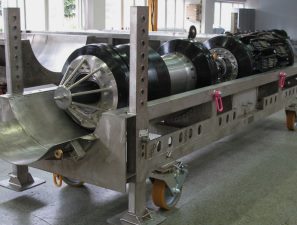Besides, two more diagnostic tools – a multi-channel geometry tool with navigation system (28/32-ПРН 28-ПРН.00-00.000) and a combined defectoscope (40-ДКК.00-00.000) were modernized. All three tools have successfully passed acceptance tests and have been accepted by the commission of Transneft, JSC”.
The combined magnetic ultrasonic in-line defectoscopes detect and specify sizes of such defects as corrosion, lamination, tool mark, cracks, - both in pipe metal and in welding joints. Their work is based on the method of magnetic flux leakage (MFL) registration and two ultrasonic methods: with ultrasonic beam direct input (WM) and with ultrasonic beam inclined input (CD).
Diagnostic complex 28-ДКК.01-00.000-02 is meant for in-line diagnostics of pipelines with diameter of 720/820 mm. It is a new tool in the line of combined magnetic ultrasonic in-line defectoscopes of such typical size. Besides, in construction of ultrasonic section of the tool the number of ultrasound detectors WM is increased by half in comparison with the previous analogues. Minimum width of the detected defects of pipe wall such as “tool mark” is decreased by 2.5 times, energy consumption of the electronic equipment is decreased by 25%.
The combined magnetic ultrasonic in-line defectoscope 40-ДКК.01-00.000 is used for in-line diagnostics of pipelines with diameter of 1020/1067/1220 mm. Upon modernization of ultrasonic section the number of detectors WM was increased by 1.6 times in comparison with the previous analogues. Minimum width of the detected defects of pipe wall such as “tool mark” is decreased by 2.5 times, energy consumption of the electronic equipment is decreased by 48%.
A modern platformless inertial navigation system, allowing measuring pipeline bending radiuses and axis coordinates to a high precision, has been installed in the modernized multi-channel geometry tool 28-КМП.00-00.000.
In total in 2015 Transneft Diascan, JSC modernized five tools and put into service two new tools, including a new-generation ultrasonic defectoscope for detecting randomly oriented defects.
.jpg)


